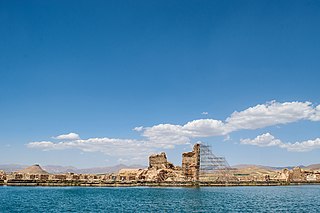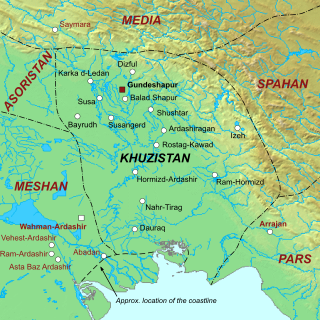Related Research Articles

Kavad I was the Sasanian King of Kings of Iran from 488 to 531, with a two or three-year interruption. A son of Peroz I, he was crowned by the nobles to replace his deposed and unpopular uncle Balash.

Hormizd IV was the Sasanian King of Kings of Iran from 579 to 590. He was the son and successor of Khosrow I and his mother was a Khazar princess.

Peroz I was the Sasanian King of Kings of Iran from 459 to 484. A son of Yazdegerd II, he disputed the rule of his elder brother and incumbent king Hormizd III, eventually seizing the throne after a two-year struggle. His reign was marked by war and famine. Early in his reign, he successfully quelled a rebellion in Caucasian Albania in the west, and put an end to the Kidarites in the east, briefly expanding Sasanian rule into Tokharistan, where he issued gold coins with his likeness at Balkh. Simultaneously, Iran was suffering from a seven-year famine. He soon clashed with the former subjects of the Kidarites, the Hephthalites, who possibly had previously helped him to gain his throne. He was defeated and captured twice by the Hephthalites and lost his recently acquired possessions.

Yazdegerd II, was the Sasanian King of Kings of Iran from 438 to 457. He was the successor and son of Bahram V.

Yazdegerd I was the Sasanian King of Kings of Iran from 399 to 420. A son of Shapur III, he succeeded his brother Bahram IV after the latter's assassination.

Bahram II was the fifth Sasanian King of Kings (shahanshah) of Iran, from 274 to 293. He was the son and successor of Bahram I. Bahram II, while still in his teens, ascended the throne with the aid of the powerful Zoroastrian priest Kartir, just like his father had done.
Religious persecution is the systematic mistreatment of an individual or a group of individuals as a response to their religious beliefs or affiliations or their lack thereof. The tendency of societies or groups within societies to alienate or repress different subcultures is a recurrent theme in human history. Moreover, because a person's religion often determines his or her morality, world view, self-image, attitudes towards others, and overall personal identity to a significant extent, religious differences can be significant cultural, personal, and social factors.

Persecution is the systematic mistreatment of an individual or group by another individual or group. The most common forms are religious persecution, racism, and political persecution, though there is naturally some overlap between these terms. The inflicting of suffering, harassment, imprisonment, internment, fear or pain are all factors that may establish persecution, but not all suffering will necessarily establish persecution. The threshold of severity has been a source of much debate.

Shirin was a Christian wife of the Sasanian King of Kings (shahanshah) Khosrow II. In the revolution after the death of Khosrow's father Hormizd IV, the General Bahram Chobin took power over the Persian empire. Shirin fled with Khosrow to Syria, where they lived under the protection of Byzantine emperor Maurice. In 591, Khosrow returned to Persia to take control of the empire and Shirin was made queen. She used her new influence to support the Christian minority in Iran, but the political situation demanded that she do so discreetly. Initially she belonged to the Church of the East, the so-called Nestorians, but later she joined the miaphysite church of Antioch, now known as the Syriac Orthodox Church. After conquering Jerusalem in 614, amidst the Byzantine–Sasanian War of 602–628, the Persians captured the True Cross of Jesus and brought it to their capital Ctesiphon, where Shirin took the cross in her palace.

Mehregan or Jashn-e Mehr is a Zoroastrian and Iranian festival celebrated to honor the yazata Mithra, which is responsible for friendship, affection and love. It is also widely referred to as the Persian Festival of Autumn.

Kartir was a powerful and influential Zoroastrian priest during the reigns of four Sasanian kings in the 3rd-century. His name is cited in the inscriptions of Shapur I and the Paikuli inscription of Narseh. Kartir also had inscriptions of his own made in the present-day Fars Province. His inscriptions narrates his rise to power throughout the reigns of Shapur I, Hormizd I, Bahram I, and Bahram II. During the brief reign of Bahram II's son and successor Bahram III, Kartir was amongst the nobles who supported the rebellion of Narseh, who overthrew Bahram III and ascended the throne. During Narseh's reign, Kartir fades into obscurity, due to not doing anything noteworthy as high priest.

Saint Anastasius of Persia, was originally a Zoroastrian soldier in the Sasanian army. He later became a convert to Christianity and was martyred in 628.
Mār Qardāgh, was a legendary Assyrian prince who was martyred for converting to Christianity.
Gabriel of Sinjar was a court physician (drustbed) of the Sasanian shah Khosrow II. He played a major role in inter-Christian rivalries in the Sasanian empire.
Varsken was an Iranian prince from the Mihranid family of Gugark, who served as the bidaxsh (margrave) of the region from 470 to 482. He was the son and successor of Arshusha II.

Adur Gushnasp was the name of a Zoroastrian sacred fire of the highest grade, which served as one of the three most sacred fires of pre-Islamic Iran; the two others being the Adur Farnbag and Adur Burzen-mihr. Out of the three, Adur Gushnasp is the only fire whose temple structure has been discovered and "for which archaeological, sigillographical, and textual evidence are all available."
The Acts of Pusai or Martyrdom of Pusai is a Syriac narrative about the martyrdom of a Christian saint named Pusai. English-speaking literature refers to this work by a variety of names, including the Martyrdom of Pusai-Qarugbed, on account of Pusai's title Qarugbed, "Head of the Craftsmen", and as the "Martyrdom of Pusay. Other variants include Acts of Mar Pusai and the Passions of Pusay.
The Martyrdom of Simeon is an account concerning the martyrdom of Simeon or Shemon Bar Sabbae, a leader in the Church of the East under the Sasanian Empire. It is one of four Syriac martyr acts, and also known by its longer name, The Martyrdom of Mar Simeon, the Archbishop of the Church of the East. It is not to be confused with the History of Simeon, another narrative about the same individual. There are conflicting chronological notes in the relevant ancient sources, but the death of Simeon must be placed in the neighborhood of 344 CE.

Karka d-Ledan, also known as Eranshahr-Shapur, and Eran asan kar(t) Kavad, was one of the four Sasanian major cities of Khuzestan. It was (re)founded by King of Kings (shahanshah) Shapur II in 338, who had a winter palace established there. Karka d-Ledan is identified with the modern site of Ivan-e Kerkha.

Khuzistan or Huzistan was a Sasanian province in Late Antiquity, which almost corresponded to the present-day province of Khuzestan. Its capital was Gundeshapur. During the late Sasanian era, the province was included in the southern quadrant (kust) of Nemroz.
References
- 1 2 3 H.A. Drake (5 December 2016). Violence in Late Antiquity: Perceptions and Practices. Taylor & Francis. p. 96. ISBN 978-1-351-87574-5.
- 1 2 3 4 Richard E. Payne (5 August 2016). A State of Mixture: Christians, Zoroastrians, and Iranian Political Culture in Late Antiquity. Univ of California Press. pp. 45–46. ISBN 978-0-520-29245-1.
- ↑ Richard E. Payne (5 August 2016). A State of Mixture: Christians, Zoroastrians, and Iranian Political Culture in Late Antiquity. Univ of California Press. p. 141. ISBN 978-0-520-29245-1.
- ↑ Clemens Gantner (3 March 2016). Visions of Community in the Post-Roman World: The West, Byzantium and the Islamic World, 300–1100. Routledge. pp. 214–215. ISBN 978-1-317-00136-2.
- ↑ Muriel Debié; David Taylor (25 October 2012). "Syriac and Syro-Arabic Historical Writing". In Andrew Feldherr; Sarah Foot; Daniel R. Woolf (eds.). The Oxford History of Historical Writing: Volume 2: 400-1400. OUP Oxford. pp. 163, 170. ISBN 978-0-19-923642-8.
- ↑ Philip Wood (29 August 2013). The Chronicle of Seert: Christian Historical Imagination in Late Antique Iraq. OUP Oxford. p. 27. ISBN 978-0-19-967067-3.